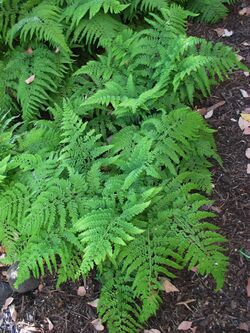Biology:Microlepia strigosa
| Microlepia strigosa | |
|---|---|

| |
| Microlepia strigosa var. strigosa | |
| Scientific classification Error creating thumbnail: Unable to save thumbnail to destination
| |
| Kingdom: | Plantae |
| Clade: | Tracheophytes |
| Division: | Polypodiophyta |
| Class: | Polypodiopsida |
| Order: | Polypodiales |
| Family: | Dennstaedtiaceae |
| Genus: | Microlepia |
| Species: | M. strigosa
|
| Binomial name | |
| Microlepia strigosa (Thunb.) C.Presl.
| |
Microlepia strigosa, known as hay-scented fern, lace fern, rigid lace fern and palapalai, is a fern indigenous to the Hawaiian islands and is also native to other parts of the tropics and subtropics including India and Malaysia.[1] This fern belongs to a group of about seventy Microlepia species in the bracken or hay-scented fern family (Dennstaedtiaceae). There are two indigenous species and a hybrid found in the main Hawaiian Islands. It is also known by the botanical names: Davallia hirta, Davallia setosa, Davallia strigosa, Dicksonia kaulfussiana, Dicksonia strigosa, Microlepia hirta, Microlepia setosa, Stenoloma tenuifolium, Trichomanes strigosum.[2] It has coarse, light to medium green fronds which can grow to more than 3 ft (0.9 m) long.
Uses
Early Hawaiians used the fronds to decorate hula altars dedicated to Laka, goddess of hula.[3] The ferns were used as head lei (lei poʻo), neck lei (lei ʻāʻī), and wrist lei (lei kūpeʻe) and to provide a soft base against the skin.[4] The plants were believed to be a cure for insanity.[5] It was also used to bathe in and young leaf fronds were fed to babies.[6]
References
- ↑ Growing plants for Hawaiian lei : 85 plants for gardens, conservation, and business. Honolulu: College of Tropical Agriculture and Human Resources, University of Hawaiʻi at Mānoa. 2002. pp. 40–41. ISBN 978-1929325139.
- ↑ "Microlepia strigosa var. strigosa". http://nativeplants.hawaii.edu/plant/view/Microlepia_strigosa_strigosa. Retrieved 26 September 2015.
- ↑ Nagata, Kenneth M. (1992). How to plant a native Hawaiian garden. Honolulu: Hawaii State Office of Environmental Quality Control.
- ↑ McDonald, Marie A. (2003). Nā lei makamae = The treasured lei. Honolulu: University of Hawaiʻi Press. pp. 131–132. ISBN 978-0824826499.
- ↑ Kaaiakamanu, D.M. (1922). Hawaiian herbs of medicinal value : found among the mountains and elsewhere in the Hawaiian Islands, and known to the Hawaiians to possess curative and palliative properties most effective in removing physical ailments. Honolulu: Board of Health of the Territory of Hawaii. p. 72. http://babel.hathitrust.org/cgi/pt?id=uc1.b5430259;view=1up;seq=79.
- ↑ Kaaiakamanu, D. M. (1917). Native Hawaiian medicine. Vol. III (2003 translation ed.). Honolulu: First People's Productions. p. 83.
External links
- GRIN-Global Web v 1.9.7.1: Taxonomy + distribution of Microlepia strigosa
- Plants for Hawaiian lei: Palapalai (accessed September 25, 2015)
- Hui ku Maoli Ola: Palapalai (accessed September 25, 2015)
- Bishop Museum Hawaiian Ethnobotany Online Database (accessed September 25, 2015)
Wikidata ☰ Q15236903 entry
 |

